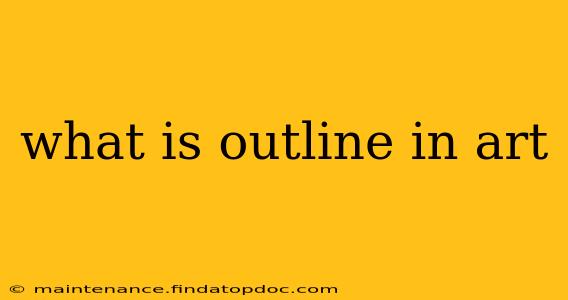An outline in art refers to the boundary line that defines the shape or form of an object, figure, or area. It's the outermost edge, the silhouette, that separates the subject from its background. While seemingly simple, the use of outline significantly impacts the overall aesthetic and message of an artwork, varying drastically depending on the artist's style and intent. Understanding outlines allows for a deeper appreciation of artistic choices and techniques.
What is the Purpose of an Outline in Art?
Outlines serve multiple crucial purposes in art:
-
Defining Shape and Form: The most fundamental role is to clearly delineate the subject's boundaries, making it easily recognizable. This is especially important in representational art, where accurate depiction is paramount.
-
Creating Depth and Dimension: While often associated with flatness, outlines can contribute to depth through variations in thickness, line weight, and the use of shading alongside the outline. A thicker line can suggest proximity, while a thinner line can indicate distance or recession.
-
Establishing Composition: Outlines help organize the elements within a composition. They guide the viewer's eye and create a sense of structure and balance. Strategic use of outlines can lead to dynamic or harmonious compositions.
-
Expressing Style and Emotion: The style of the outline – bold, delicate, shaky, precise – contributes greatly to the overall feeling of the artwork. A bold, confident outline might convey strength and authority, while a delicate, hesitant line could suggest fragility or vulnerability.
Different Types of Outlines in Art
Outlines aren't always uniform. Artists employ diverse techniques to create varied effects:
-
Hard Outline: This is a sharp, clearly defined line, often found in cartoons, graphic novels, and some forms of printmaking. It creates a distinct separation between the subject and background.
-
Soft Outline: A less defined line, often subtly implied through changes in color or value. This type of outline creates a more fluid, less rigid appearance. It's common in paintings and drawings where a sense of realism is desired.
-
Implied Outline: This is an outline created not by a drawn line, but by the juxtaposition of shapes and colors. The viewer perceives the outline despite its absence as a distinct line.
-
Broken Outline: This style utilizes a series of short, discontinuous lines or dashes to define the form. This can add a sense of movement or energy.
-
Variable Line Weight: Changing the thickness of the outline throughout the drawing creates visual interest and can be used to direct the viewer’s eye and indicate depth.
How is Outline Used in Different Art Styles?
The use of outlines varies significantly across artistic movements and styles:
-
Cartooning and Illustration: Outlines are heavily emphasized, often bold and black, to provide clear definition and legibility.
-
Realism and Impressionism: Outlines are often softer, less defined, or even implied to create a sense of naturalism.
-
Abstract Art: Outlines might be absent altogether, or used in unconventional ways to explore form and composition.
-
Line Art: Entirely based on linework, emphasizing the expressive potential of the outline itself.
Is an Outline Necessary in Art?
No, an outline isn't always necessary in art. Many styles, such as some forms of abstract art and impressionism, often minimize or completely omit outlines. The absence of an outline can create a sense of fluidity and ambiguity. The choice to use or omit an outline is a stylistic decision dependent on the artist's vision and the desired effect.
Frequently Asked Questions
What is the difference between contour lines and outlines?
While often used interchangeably, contour lines depict the outer edges of a three-dimensional form, showing its curves and surfaces, while outlines simply define the outermost boundary of a shape in a two-dimensional space. Contour lines offer more information about the form’s three-dimensionality than an outline.
How do I improve my outlining skills?
Practice is key! Start with simple shapes and gradually increase complexity. Experiment with different line weights and techniques to find what suits your style. Observing and analyzing outlines in the work of other artists can also be beneficial.
Can outlines be used in digital art?
Absolutely! Digital art programs provide various tools for creating and manipulating outlines, offering greater flexibility and control.
This comprehensive guide explores the multifaceted nature of outlines in art, highlighting their significance in defining forms, conveying emotions, and shaping artistic styles. Understanding the role of outlines deepens appreciation for the artistic choices made by creators across various media and historical periods.
